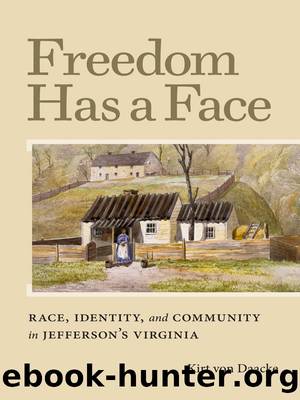Freedom Has a Face by Kirt von Daacke

Author:Kirt von Daacke [Daacke, Kirt von]
Language: eng
Format: epub
Tags: History, United States, Revolutionary Period (1775-1800)
ISBN: 9780813933108
Google: OF1xQJHzD_oC
Publisher: University of Virginia Press
Published: 2012-10-30T16:05:30+00:00
5
Bawdy Houses and Women of Ill Fame
Free Black Women, Prostitution, and Family
On July 9, 1821, the free woman of color Fanny Barnett came to the Albemarle County courthouse in Charlottesville to file a fifty-dollar recognizance guaranteeing her appearance at the next monthâs county court to answer charges of a âbreach of the peace and for a riotous and unlawful assembly.â The white resident Benjamin Austin acted as surety for Barnett, filing his own fifty-dollar bond for her appearance. Also charged for the same offense that day were the white men Edmund Wade, Joshua Grady, and Bennett Wheeler. Two whitesâAndrew McKee and Solomon Ballardâposted security for those men. Finally, two white women, Nancy Riley and Betsey Wingfield, found themselves similarly charged with a breach of the peace. The indictment described all of them, white and black, as ânot of good fame, nor of honest conversation, but evil doers, rioters, disturbers of the peace.â1
Although the details of the disturbance no longer remain in the records, the above indictment contains within it the outlines of a picture of one side of life in the little nineteenth-century town of Charlottesville. The people named in the court papers regarding the indictment were all neighbors, living and working close to one another. Andrew McKee, a white man, worked as a hatter. The blacksmith Joshua Grady, also white, cohabited with the free black woman Betsy Ann Farley. Nancy Riley and Betsey Wingfield were unmarried white women. Fanny Barnett, age thirty-five, was a free woman of color who owned little or no property.2
This episode in the summer of 1821 reveals far more, however, than simply disorderly interaction between free blacks and whites of the lower and middling sorts. Each of those charged managed to find a white man to come to the courthouse and pledge security for him or her. The whites Benjamin Austin, Solomon Ballard, Bennett Wheeler, and Andrew McKee clearly did not see Barnett, Riley, Wingfield, Grady, Wade, and Wheeler as âevil doers not of good fameâ who were not to be trusted. Those recognizances, with the financial obligation inhering in them, demonstrate a certain level of trust among all of these people, including both a free black woman and a poor white man living with another free black woman as if husband and wife. Further, the incident represents the first documented contact among Fanny Barnett, Nancy Riley, and Betsey Wingfield. Justices of the Peace Opie Norris and John R. Jones, in filing the complaint, described the participants in the affray as ânot of good fame, nor of honest conversation.â
Surely involvement in disorderly conduct on a village street typically would not be enough to warrant such official opprobrium. Two legislative petitions from 1815 and 1818 suggest that at least for several years prior to 1821, town trustees had attempted unsuccessfully to control illicit activities (prostitution, gambling, and the like) on the outskirts of town. The first petition, rejected by the General Assembly in 1815, sought to extend town boundaries by a mile in order to bring âsome houses of ill fameâ within town jurisdiction âfor the purpose of suppressing riots.
Download
This site does not store any files on its server. We only index and link to content provided by other sites. Please contact the content providers to delete copyright contents if any and email us, we'll remove relevant links or contents immediately.
| Americas | African Americans |
| Civil War | Colonial Period |
| Immigrants | Revolution & Founding |
| State & Local |
In Cold Blood by Truman Capote(3306)
The Innovators: How a Group of Hackers, Geniuses, and Geeks Created the Digital Revolution by Walter Isaacson(2834)
Steve Jobs by Walter Isaacson(2832)
All the President's Men by Carl Bernstein & Bob Woodward(2327)
Lonely Planet New York City by Lonely Planet(2171)
And the Band Played On by Randy Shilts(2129)
The Room Where It Happened by John Bolton;(2103)
The Poisoner's Handbook by Deborah Blum(2091)
The Murder of Marilyn Monroe by Jay Margolis(2058)
The Innovators by Walter Isaacson(2055)
Lincoln by David Herbert Donald(1944)
A Colony in a Nation by Chris Hayes(1880)
Under the Banner of Heaven: A Story of Violent Faith by Jon Krakauer(1746)
Amelia Earhart by Doris L. Rich(1648)
The Unsettlers by Mark Sundeen(1645)
Birdmen by Lawrence Goldstone(1618)
Being George Washington by Beck Glenn(1613)
Dirt by Bill Buford(1611)
Zeitoun by Dave Eggers(1590)
